COIT20248: Information Systems Analysis and Design Assignment Report
VerifiedAdded on 2023/05/26
|12
|2058
|328
Report
AI Summary
This report presents a comprehensive analysis of an online funding system designed for the "Go Help Me" (GHE) organization, a charitable entity. The report begins with an introduction outlining the project's objectives and scope, followed by a detailed explanation of the chosen systems development approach: the waterfall model. It then delves into the system requirements, differentiating between functional and non-functional aspects, and proceeds to conduct a thorough cost-benefit analysis, presenting financial feasibility metrics. A project schedule, including task durations and dependencies, is provided, complemented by a Gantt chart for visual representation. The report also explores system information requirement investigation techniques, such as interviews and questionnaires. Finally, it concludes with reflections on the project management process and the lessons learned during the system development lifecycle, emphasizing the importance of project management techniques for successful project outcomes.
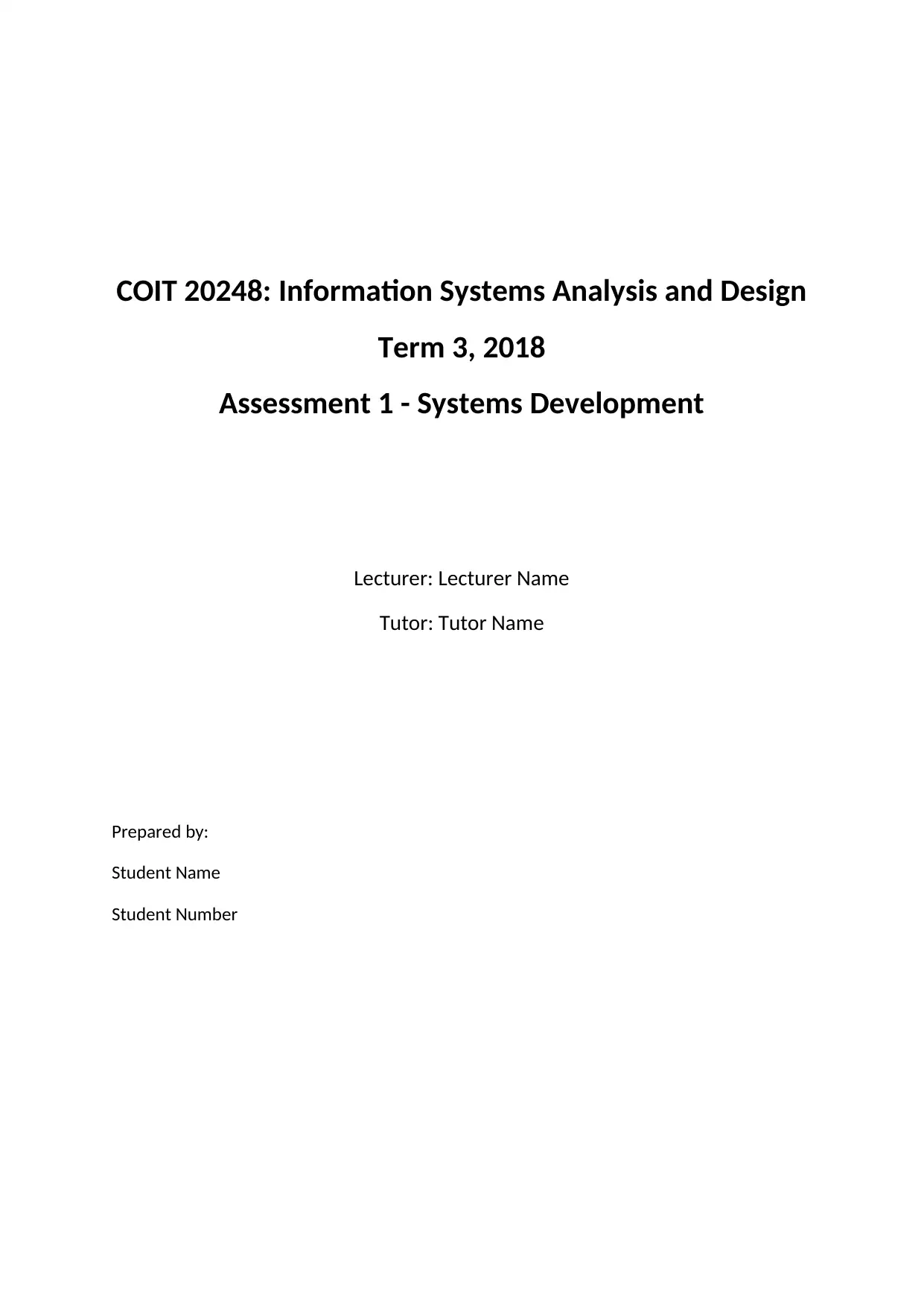
COIT 20248: Information Systems Analysis and Design
Term 3, 2018
Assessment 1 - Systems Development
Lecturer: Lecturer Name
Tutor: Tutor Name
Prepared by:
Student Name
Student Number
Term 3, 2018
Assessment 1 - Systems Development
Lecturer: Lecturer Name
Tutor: Tutor Name
Prepared by:
Student Name
Student Number
Paraphrase This Document
Need a fresh take? Get an instant paraphrase of this document with our AI Paraphraser
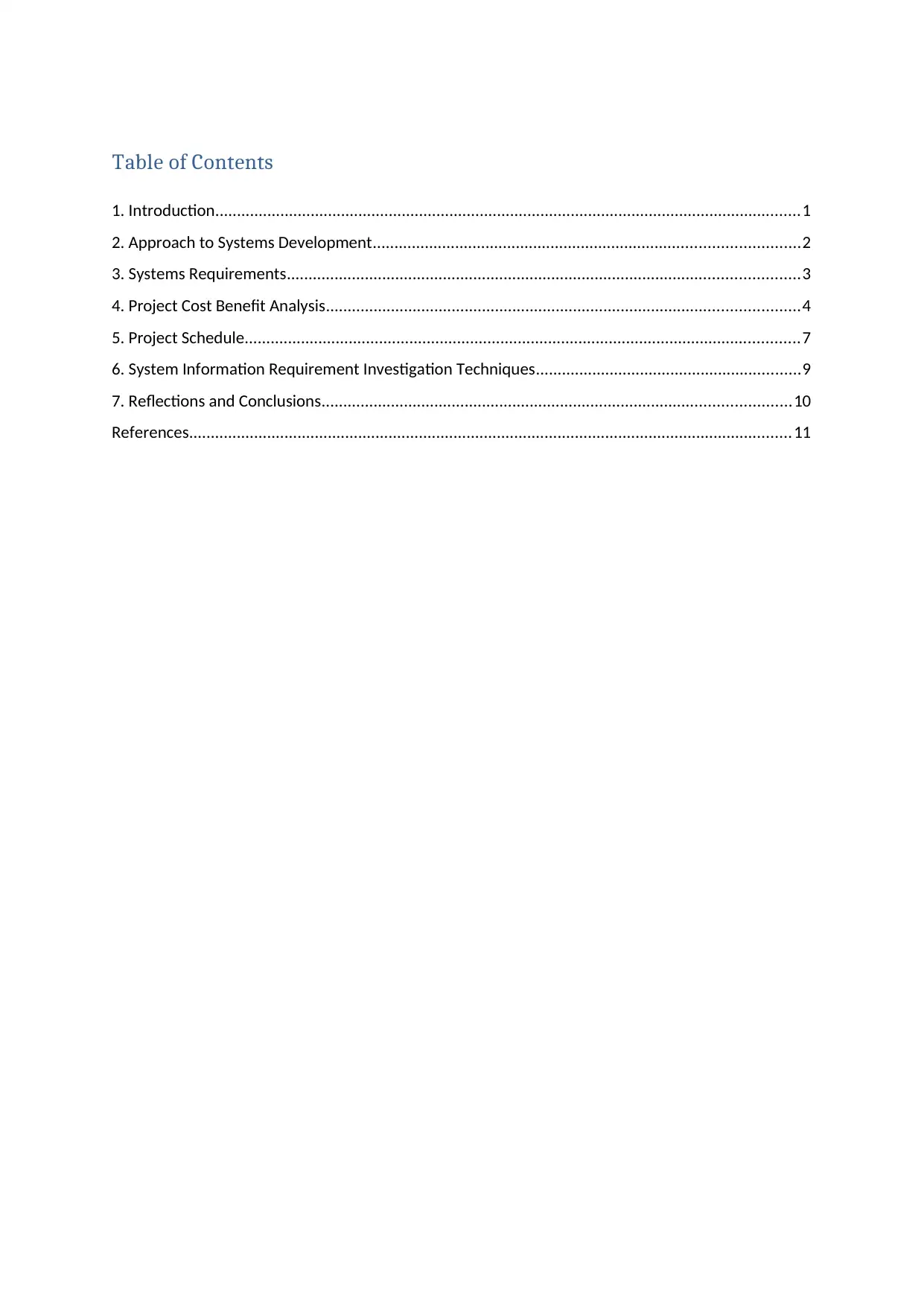
Table of Contents
1. Introduction.......................................................................................................................................1
2. Approach to Systems Development..................................................................................................2
3. Systems Requirements......................................................................................................................3
4. Project Cost Benefit Analysis.............................................................................................................4
5. Project Schedule................................................................................................................................7
6. System Information Requirement Investigation Techniques.............................................................9
7. Reflections and Conclusions............................................................................................................10
References...........................................................................................................................................11
1. Introduction.......................................................................................................................................1
2. Approach to Systems Development..................................................................................................2
3. Systems Requirements......................................................................................................................3
4. Project Cost Benefit Analysis.............................................................................................................4
5. Project Schedule................................................................................................................................7
6. System Information Requirement Investigation Techniques.............................................................9
7. Reflections and Conclusions............................................................................................................10
References...........................................................................................................................................11
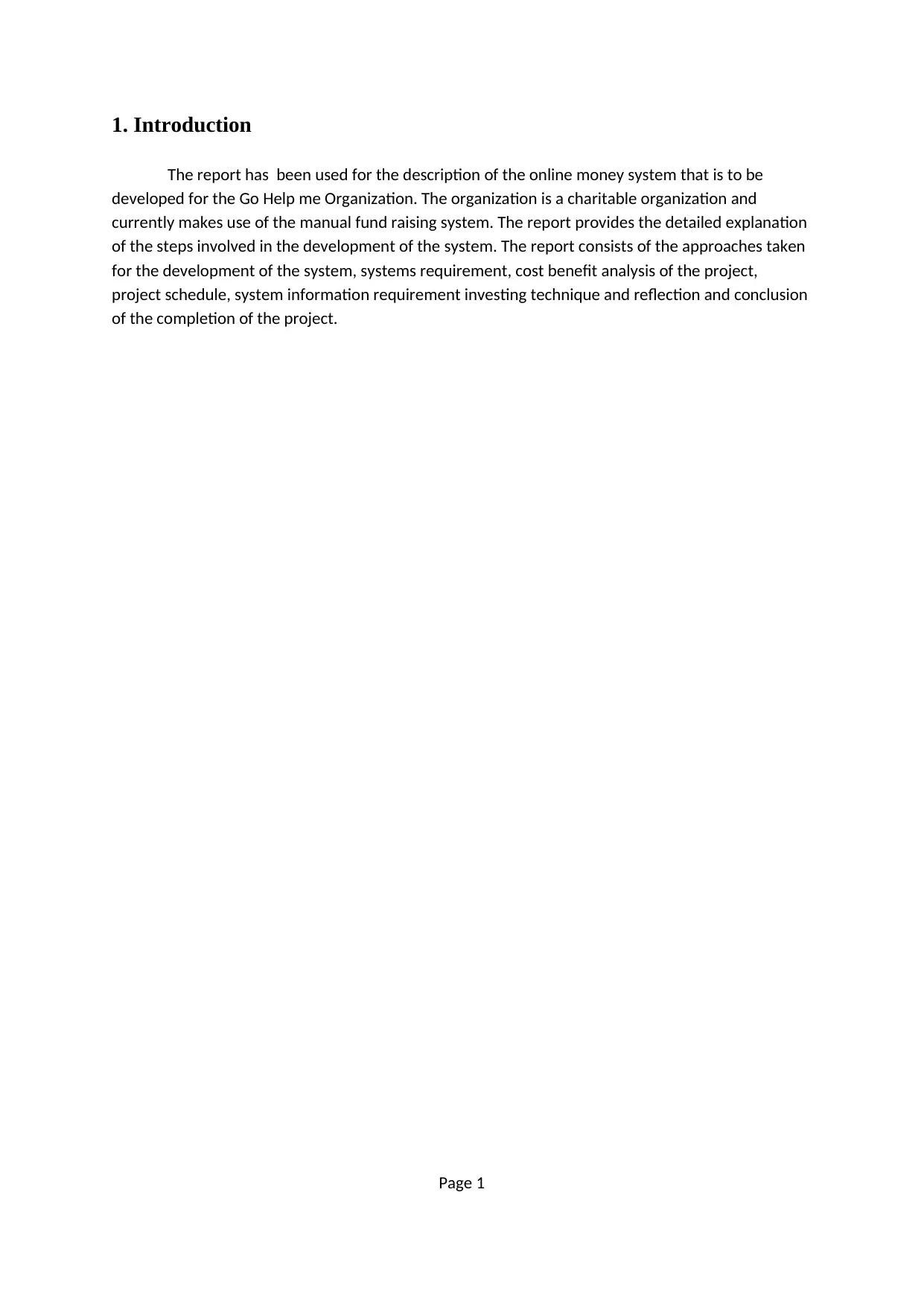
1. Introduction
The report has been used for the description of the online money system that is to be
developed for the Go Help me Organization. The organization is a charitable organization and
currently makes use of the manual fund raising system. The report provides the detailed explanation
of the steps involved in the development of the system. The report consists of the approaches taken
for the development of the system, systems requirement, cost benefit analysis of the project,
project schedule, system information requirement investing technique and reflection and conclusion
of the completion of the project.
Page 1
The report has been used for the description of the online money system that is to be
developed for the Go Help me Organization. The organization is a charitable organization and
currently makes use of the manual fund raising system. The report provides the detailed explanation
of the steps involved in the development of the system. The report consists of the approaches taken
for the development of the system, systems requirement, cost benefit analysis of the project,
project schedule, system information requirement investing technique and reflection and conclusion
of the completion of the project.
Page 1
⊘ This is a preview!⊘
Do you want full access?
Subscribe today to unlock all pages.

Trusted by 1+ million students worldwide
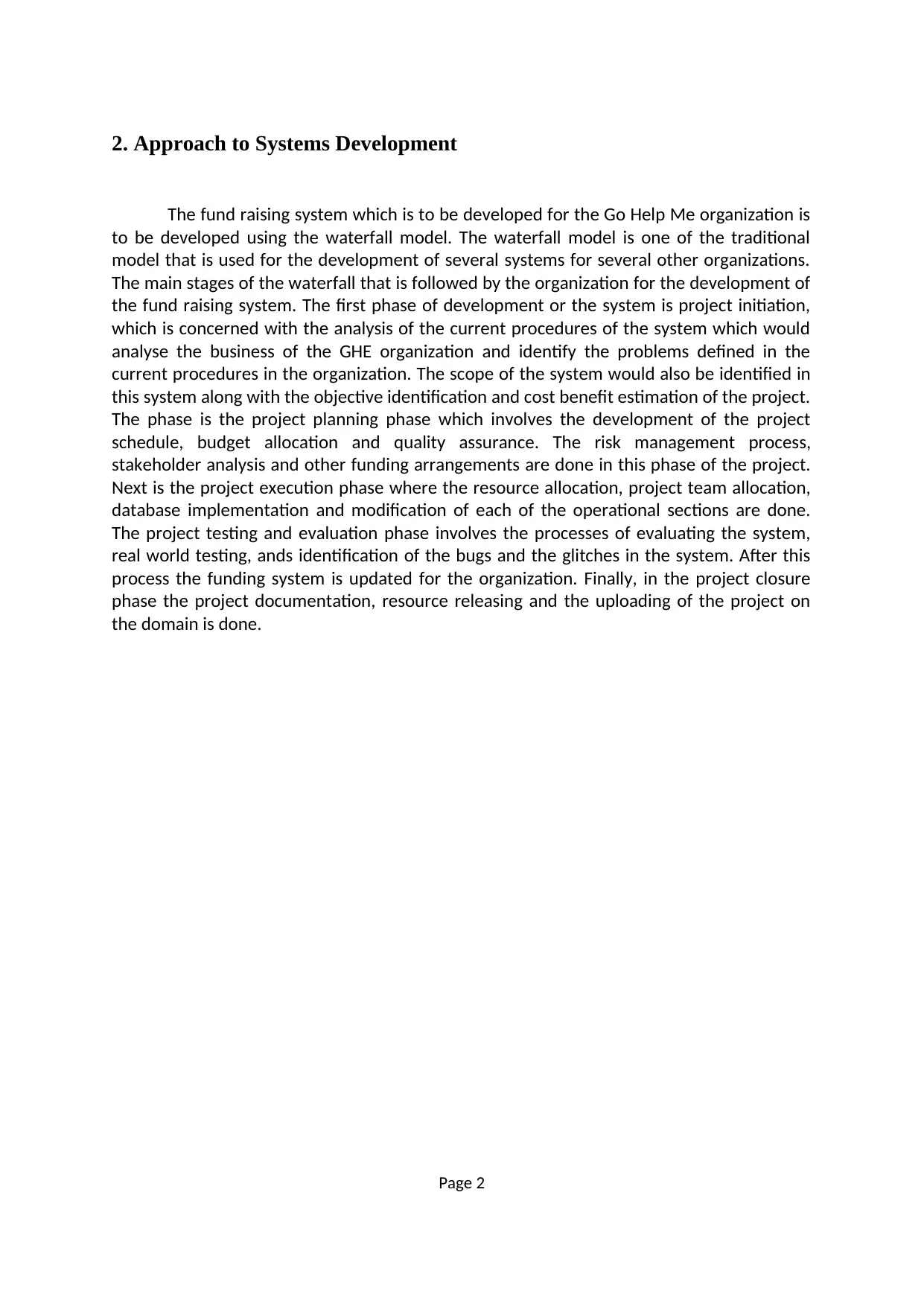
2. Approach to Systems Development
The fund raising system which is to be developed for the Go Help Me organization is
to be developed using the waterfall model. The waterfall model is one of the traditional
model that is used for the development of several systems for several other organizations.
The main stages of the waterfall that is followed by the organization for the development of
the fund raising system. The first phase of development or the system is project initiation,
which is concerned with the analysis of the current procedures of the system which would
analyse the business of the GHE organization and identify the problems defined in the
current procedures in the organization. The scope of the system would also be identified in
this system along with the objective identification and cost benefit estimation of the project.
The phase is the project planning phase which involves the development of the project
schedule, budget allocation and quality assurance. The risk management process,
stakeholder analysis and other funding arrangements are done in this phase of the project.
Next is the project execution phase where the resource allocation, project team allocation,
database implementation and modification of each of the operational sections are done.
The project testing and evaluation phase involves the processes of evaluating the system,
real world testing, ands identification of the bugs and the glitches in the system. After this
process the funding system is updated for the organization. Finally, in the project closure
phase the project documentation, resource releasing and the uploading of the project on
the domain is done.
Page 2
The fund raising system which is to be developed for the Go Help Me organization is
to be developed using the waterfall model. The waterfall model is one of the traditional
model that is used for the development of several systems for several other organizations.
The main stages of the waterfall that is followed by the organization for the development of
the fund raising system. The first phase of development or the system is project initiation,
which is concerned with the analysis of the current procedures of the system which would
analyse the business of the GHE organization and identify the problems defined in the
current procedures in the organization. The scope of the system would also be identified in
this system along with the objective identification and cost benefit estimation of the project.
The phase is the project planning phase which involves the development of the project
schedule, budget allocation and quality assurance. The risk management process,
stakeholder analysis and other funding arrangements are done in this phase of the project.
Next is the project execution phase where the resource allocation, project team allocation,
database implementation and modification of each of the operational sections are done.
The project testing and evaluation phase involves the processes of evaluating the system,
real world testing, ands identification of the bugs and the glitches in the system. After this
process the funding system is updated for the organization. Finally, in the project closure
phase the project documentation, resource releasing and the uploading of the project on
the domain is done.
Page 2
Paraphrase This Document
Need a fresh take? Get an instant paraphrase of this document with our AI Paraphraser
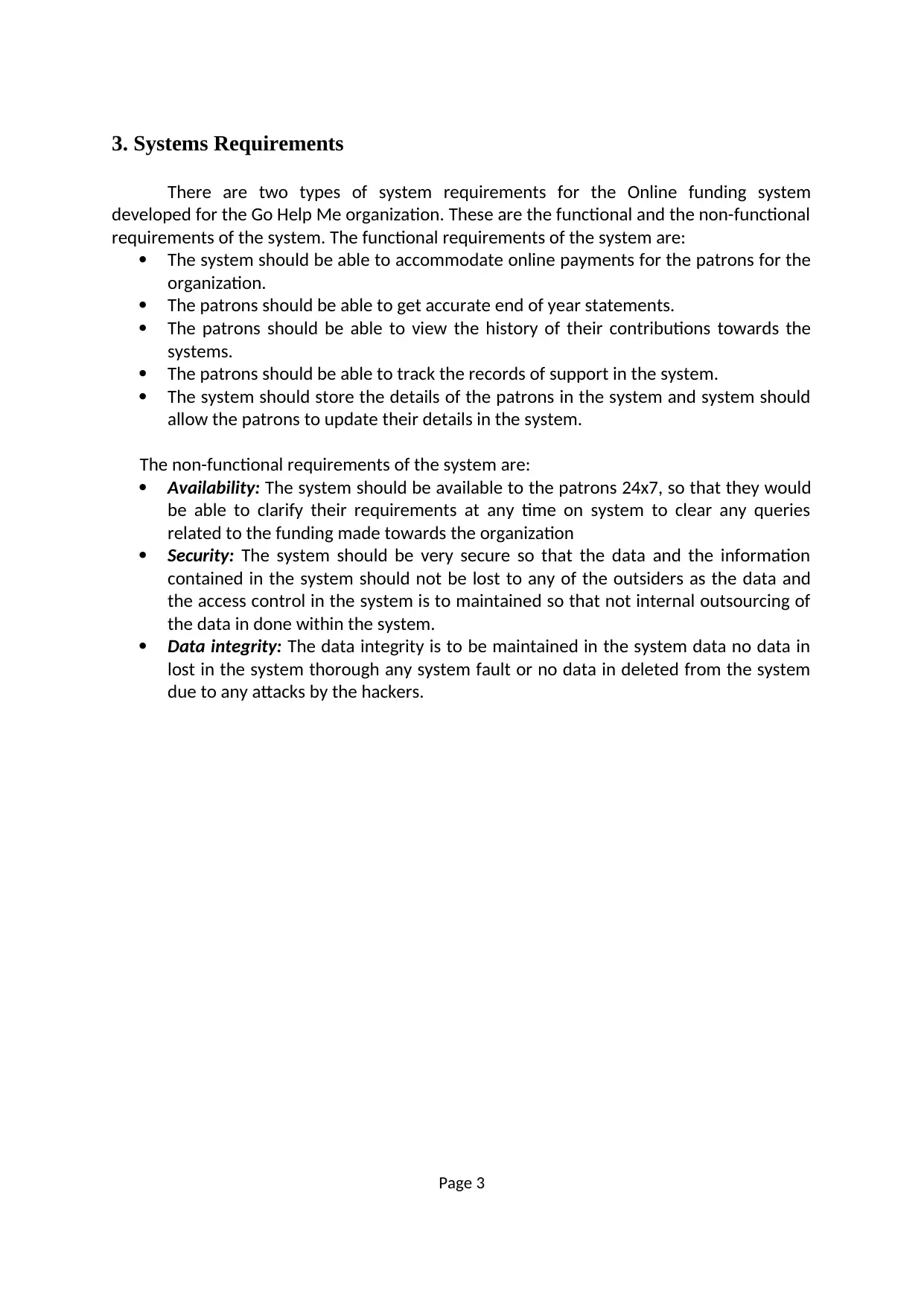
3. Systems Requirements
There are two types of system requirements for the Online funding system
developed for the Go Help Me organization. These are the functional and the non-functional
requirements of the system. The functional requirements of the system are:
The system should be able to accommodate online payments for the patrons for the
organization.
The patrons should be able to get accurate end of year statements.
The patrons should be able to view the history of their contributions towards the
systems.
The patrons should be able to track the records of support in the system.
The system should store the details of the patrons in the system and system should
allow the patrons to update their details in the system.
The non-functional requirements of the system are:
Availability: The system should be available to the patrons 24x7, so that they would
be able to clarify their requirements at any time on system to clear any queries
related to the funding made towards the organization
Security: The system should be very secure so that the data and the information
contained in the system should not be lost to any of the outsiders as the data and
the access control in the system is to maintained so that not internal outsourcing of
the data in done within the system.
Data integrity: The data integrity is to be maintained in the system data no data in
lost in the system thorough any system fault or no data in deleted from the system
due to any attacks by the hackers.
Page 3
There are two types of system requirements for the Online funding system
developed for the Go Help Me organization. These are the functional and the non-functional
requirements of the system. The functional requirements of the system are:
The system should be able to accommodate online payments for the patrons for the
organization.
The patrons should be able to get accurate end of year statements.
The patrons should be able to view the history of their contributions towards the
systems.
The patrons should be able to track the records of support in the system.
The system should store the details of the patrons in the system and system should
allow the patrons to update their details in the system.
The non-functional requirements of the system are:
Availability: The system should be available to the patrons 24x7, so that they would
be able to clarify their requirements at any time on system to clear any queries
related to the funding made towards the organization
Security: The system should be very secure so that the data and the information
contained in the system should not be lost to any of the outsiders as the data and
the access control in the system is to maintained so that not internal outsourcing of
the data in done within the system.
Data integrity: The data integrity is to be maintained in the system data no data in
lost in the system thorough any system fault or no data in deleted from the system
due to any attacks by the hackers.
Page 3
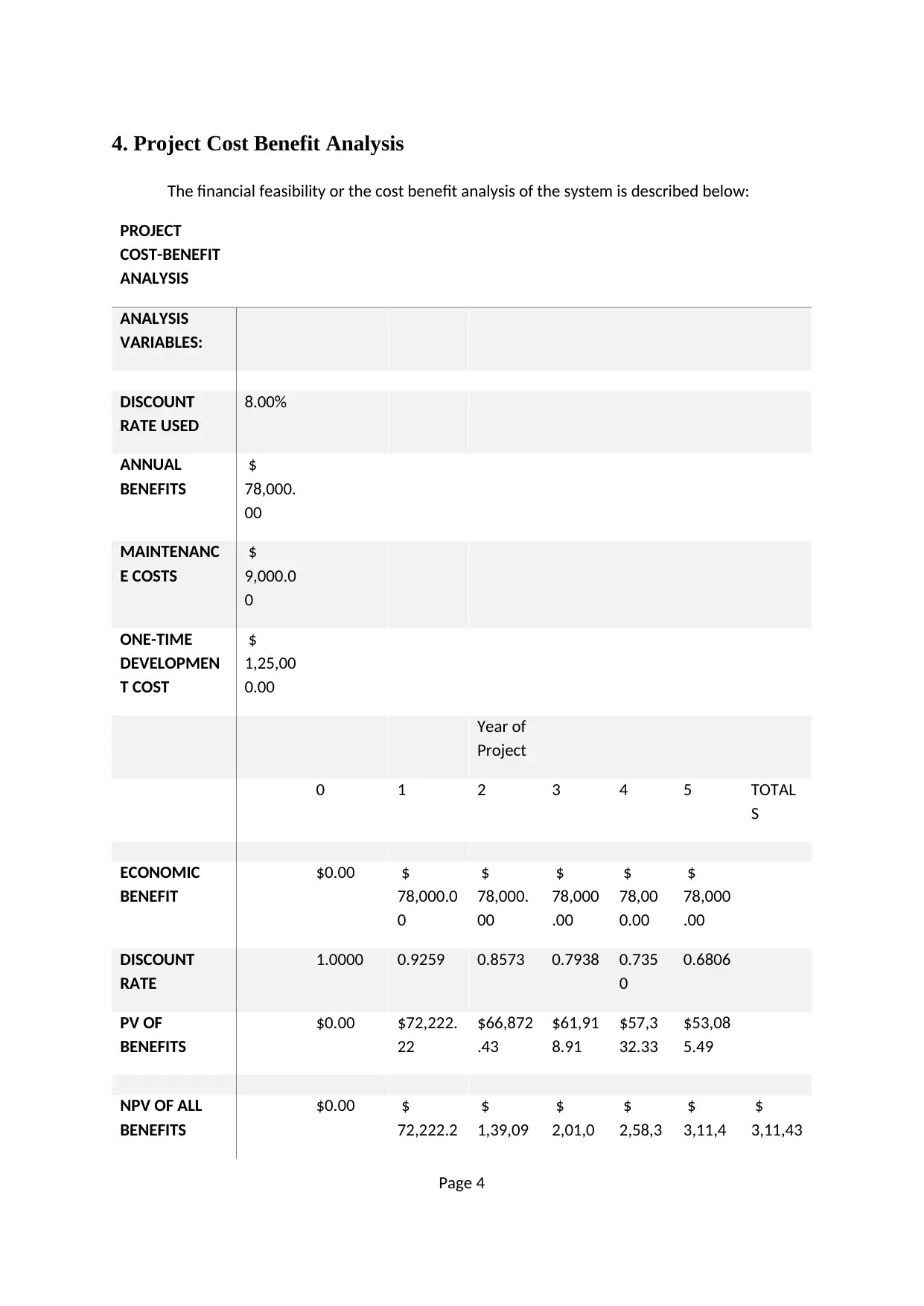
4. Project Cost Benefit Analysis
The financial feasibility or the cost benefit analysis of the system is described below:
PROJECT
COST-BENEFIT
ANALYSIS
ANALYSIS
VARIABLES:
DISCOUNT
RATE USED
8.00%
ANNUAL
BENEFITS
$
78,000.
00
MAINTENANC
E COSTS
$
9,000.0
0
ONE-TIME
DEVELOPMEN
T COST
$
1,25,00
0.00
Year of
Project
0 1 2 3 4 5 TOTAL
S
ECONOMIC
BENEFIT
$0.00 $
78,000.0
0
$
78,000.
00
$
78,000
.00
$
78,00
0.00
$
78,000
.00
DISCOUNT
RATE
1.0000 0.9259 0.8573 0.7938 0.735
0
0.6806
PV OF
BENEFITS
$0.00 $72,222.
22
$66,872
.43
$61,91
8.91
$57,3
32.33
$53,08
5.49
NPV OF ALL
BENEFITS
$0.00 $
72,222.2
$
1,39,09
$
2,01,0
$
2,58,3
$
3,11,4
$
3,11,43
Page 4
The financial feasibility or the cost benefit analysis of the system is described below:
PROJECT
COST-BENEFIT
ANALYSIS
ANALYSIS
VARIABLES:
DISCOUNT
RATE USED
8.00%
ANNUAL
BENEFITS
$
78,000.
00
MAINTENANC
E COSTS
$
9,000.0
0
ONE-TIME
DEVELOPMEN
T COST
$
1,25,00
0.00
Year of
Project
0 1 2 3 4 5 TOTAL
S
ECONOMIC
BENEFIT
$0.00 $
78,000.0
0
$
78,000.
00
$
78,000
.00
$
78,00
0.00
$
78,000
.00
DISCOUNT
RATE
1.0000 0.9259 0.8573 0.7938 0.735
0
0.6806
PV OF
BENEFITS
$0.00 $72,222.
22
$66,872
.43
$61,91
8.91
$57,3
32.33
$53,08
5.49
NPV OF ALL
BENEFITS
$0.00 $
72,222.2
$
1,39,09
$
2,01,0
$
2,58,3
$
3,11,4
$
3,11,43
Page 4
⊘ This is a preview!⊘
Do you want full access?
Subscribe today to unlock all pages.

Trusted by 1+ million students worldwide
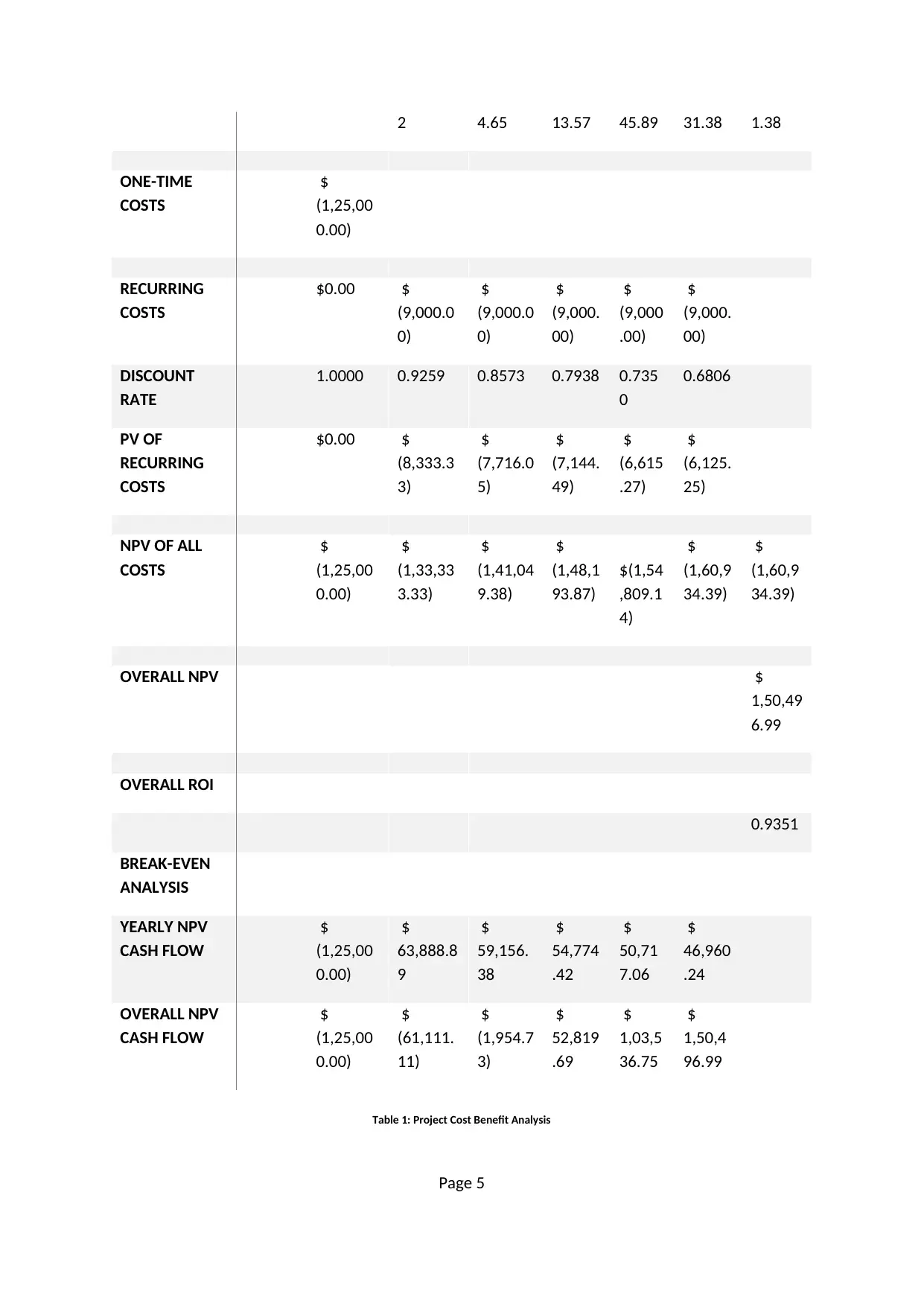
2 4.65 13.57 45.89 31.38 1.38
ONE-TIME
COSTS
$
(1,25,00
0.00)
RECURRING
COSTS
$0.00 $
(9,000.0
0)
$
(9,000.0
0)
$
(9,000.
00)
$
(9,000
.00)
$
(9,000.
00)
DISCOUNT
RATE
1.0000 0.9259 0.8573 0.7938 0.735
0
0.6806
PV OF
RECURRING
COSTS
$0.00 $
(8,333.3
3)
$
(7,716.0
5)
$
(7,144.
49)
$
(6,615
.27)
$
(6,125.
25)
NPV OF ALL
COSTS
$
(1,25,00
0.00)
$
(1,33,33
3.33)
$
(1,41,04
9.38)
$
(1,48,1
93.87)
$(1,54
,809.1
4)
$
(1,60,9
34.39)
$
(1,60,9
34.39)
OVERALL NPV $
1,50,49
6.99
OVERALL ROI
0.9351
BREAK-EVEN
ANALYSIS
YEARLY NPV
CASH FLOW
$
(1,25,00
0.00)
$
63,888.8
9
$
59,156.
38
$
54,774
.42
$
50,71
7.06
$
46,960
.24
OVERALL NPV
CASH FLOW
$
(1,25,00
0.00)
$
(61,111.
11)
$
(1,954.7
3)
$
52,819
.69
$
1,03,5
36.75
$
1,50,4
96.99
Table 1: Project Cost Benefit Analysis
Page 5
ONE-TIME
COSTS
$
(1,25,00
0.00)
RECURRING
COSTS
$0.00 $
(9,000.0
0)
$
(9,000.0
0)
$
(9,000.
00)
$
(9,000
.00)
$
(9,000.
00)
DISCOUNT
RATE
1.0000 0.9259 0.8573 0.7938 0.735
0
0.6806
PV OF
RECURRING
COSTS
$0.00 $
(8,333.3
3)
$
(7,716.0
5)
$
(7,144.
49)
$
(6,615
.27)
$
(6,125.
25)
NPV OF ALL
COSTS
$
(1,25,00
0.00)
$
(1,33,33
3.33)
$
(1,41,04
9.38)
$
(1,48,1
93.87)
$(1,54
,809.1
4)
$
(1,60,9
34.39)
$
(1,60,9
34.39)
OVERALL NPV $
1,50,49
6.99
OVERALL ROI
0.9351
BREAK-EVEN
ANALYSIS
YEARLY NPV
CASH FLOW
$
(1,25,00
0.00)
$
63,888.8
9
$
59,156.
38
$
54,774
.42
$
50,71
7.06
$
46,960
.24
OVERALL NPV
CASH FLOW
$
(1,25,00
0.00)
$
(61,111.
11)
$
(1,954.7
3)
$
52,819
.69
$
1,03,5
36.75
$
1,50,4
96.99
Table 1: Project Cost Benefit Analysis
Page 5
Paraphrase This Document
Need a fresh take? Get an instant paraphrase of this document with our AI Paraphraser
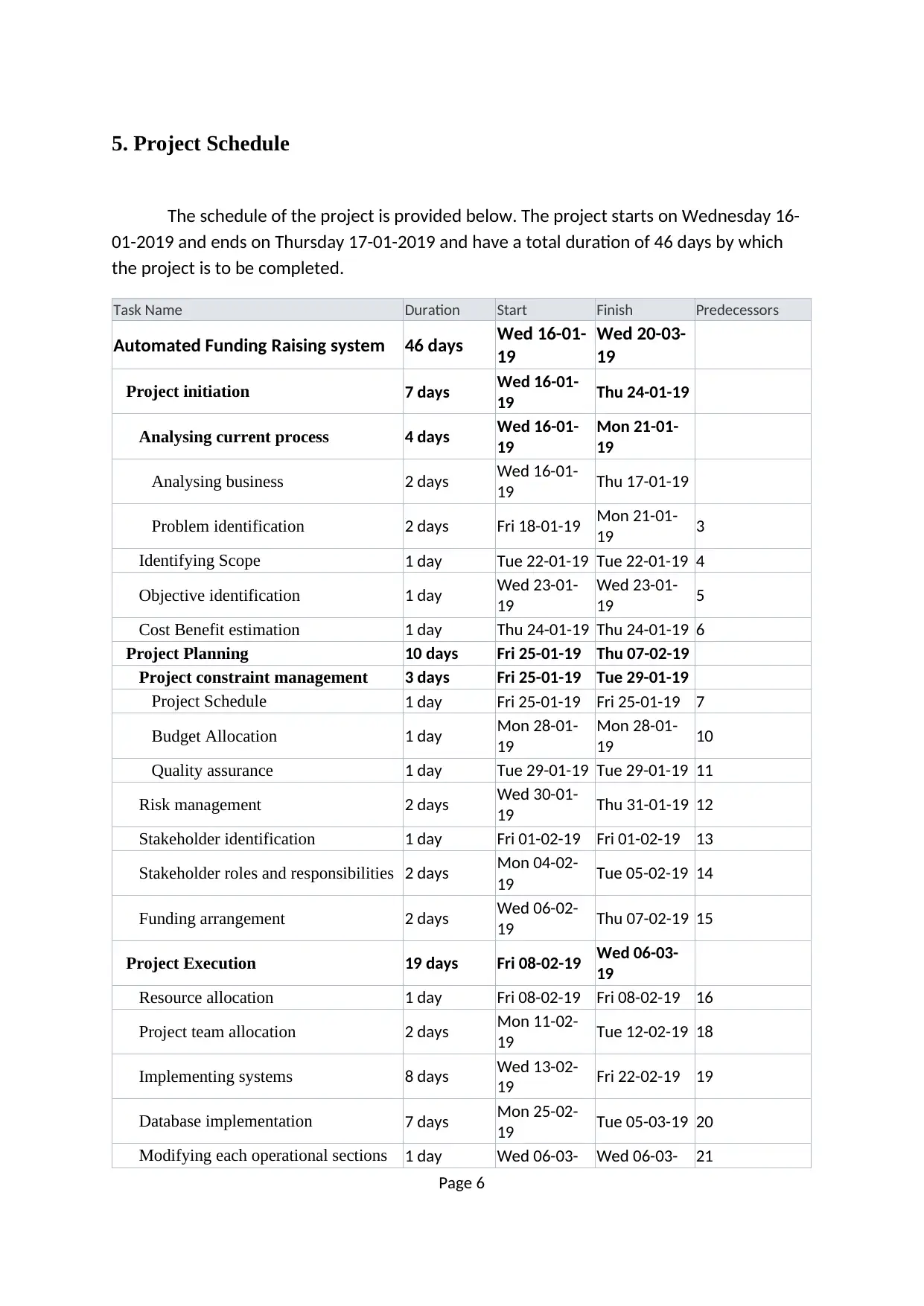
5. Project Schedule
The schedule of the project is provided below. The project starts on Wednesday 16-
01-2019 and ends on Thursday 17-01-2019 and have a total duration of 46 days by which
the project is to be completed.
Task Name Duration Start Finish Predecessors
Automated Funding Raising system 46 days Wed 16-01-
19
Wed 20-03-
19
Project initiation 7 days Wed 16-01-
19 Thu 24-01-19
Analysing current process 4 days Wed 16-01-
19
Mon 21-01-
19
Analysing business 2 days Wed 16-01-
19 Thu 17-01-19
Problem identification 2 days Fri 18-01-19 Mon 21-01-
19 3
Identifying Scope 1 day Tue 22-01-19 Tue 22-01-19 4
Objective identification 1 day Wed 23-01-
19
Wed 23-01-
19 5
Cost Benefit estimation 1 day Thu 24-01-19 Thu 24-01-19 6
Project Planning 10 days Fri 25-01-19 Thu 07-02-19
Project constraint management 3 days Fri 25-01-19 Tue 29-01-19
Project Schedule 1 day Fri 25-01-19 Fri 25-01-19 7
Budget Allocation 1 day Mon 28-01-
19
Mon 28-01-
19 10
Quality assurance 1 day Tue 29-01-19 Tue 29-01-19 11
Risk management 2 days Wed 30-01-
19 Thu 31-01-19 12
Stakeholder identification 1 day Fri 01-02-19 Fri 01-02-19 13
Stakeholder roles and responsibilities 2 days Mon 04-02-
19 Tue 05-02-19 14
Funding arrangement 2 days Wed 06-02-
19 Thu 07-02-19 15
Project Execution 19 days Fri 08-02-19 Wed 06-03-
19
Resource allocation 1 day Fri 08-02-19 Fri 08-02-19 16
Project team allocation 2 days Mon 11-02-
19 Tue 12-02-19 18
Implementing systems 8 days Wed 13-02-
19 Fri 22-02-19 19
Database implementation 7 days Mon 25-02-
19 Tue 05-03-19 20
Modifying each operational sections 1 day Wed 06-03- Wed 06-03- 21
Page 6
The schedule of the project is provided below. The project starts on Wednesday 16-
01-2019 and ends on Thursday 17-01-2019 and have a total duration of 46 days by which
the project is to be completed.
Task Name Duration Start Finish Predecessors
Automated Funding Raising system 46 days Wed 16-01-
19
Wed 20-03-
19
Project initiation 7 days Wed 16-01-
19 Thu 24-01-19
Analysing current process 4 days Wed 16-01-
19
Mon 21-01-
19
Analysing business 2 days Wed 16-01-
19 Thu 17-01-19
Problem identification 2 days Fri 18-01-19 Mon 21-01-
19 3
Identifying Scope 1 day Tue 22-01-19 Tue 22-01-19 4
Objective identification 1 day Wed 23-01-
19
Wed 23-01-
19 5
Cost Benefit estimation 1 day Thu 24-01-19 Thu 24-01-19 6
Project Planning 10 days Fri 25-01-19 Thu 07-02-19
Project constraint management 3 days Fri 25-01-19 Tue 29-01-19
Project Schedule 1 day Fri 25-01-19 Fri 25-01-19 7
Budget Allocation 1 day Mon 28-01-
19
Mon 28-01-
19 10
Quality assurance 1 day Tue 29-01-19 Tue 29-01-19 11
Risk management 2 days Wed 30-01-
19 Thu 31-01-19 12
Stakeholder identification 1 day Fri 01-02-19 Fri 01-02-19 13
Stakeholder roles and responsibilities 2 days Mon 04-02-
19 Tue 05-02-19 14
Funding arrangement 2 days Wed 06-02-
19 Thu 07-02-19 15
Project Execution 19 days Fri 08-02-19 Wed 06-03-
19
Resource allocation 1 day Fri 08-02-19 Fri 08-02-19 16
Project team allocation 2 days Mon 11-02-
19 Tue 12-02-19 18
Implementing systems 8 days Wed 13-02-
19 Fri 22-02-19 19
Database implementation 7 days Mon 25-02-
19 Tue 05-03-19 20
Modifying each operational sections 1 day Wed 06-03- Wed 06-03- 21
Page 6
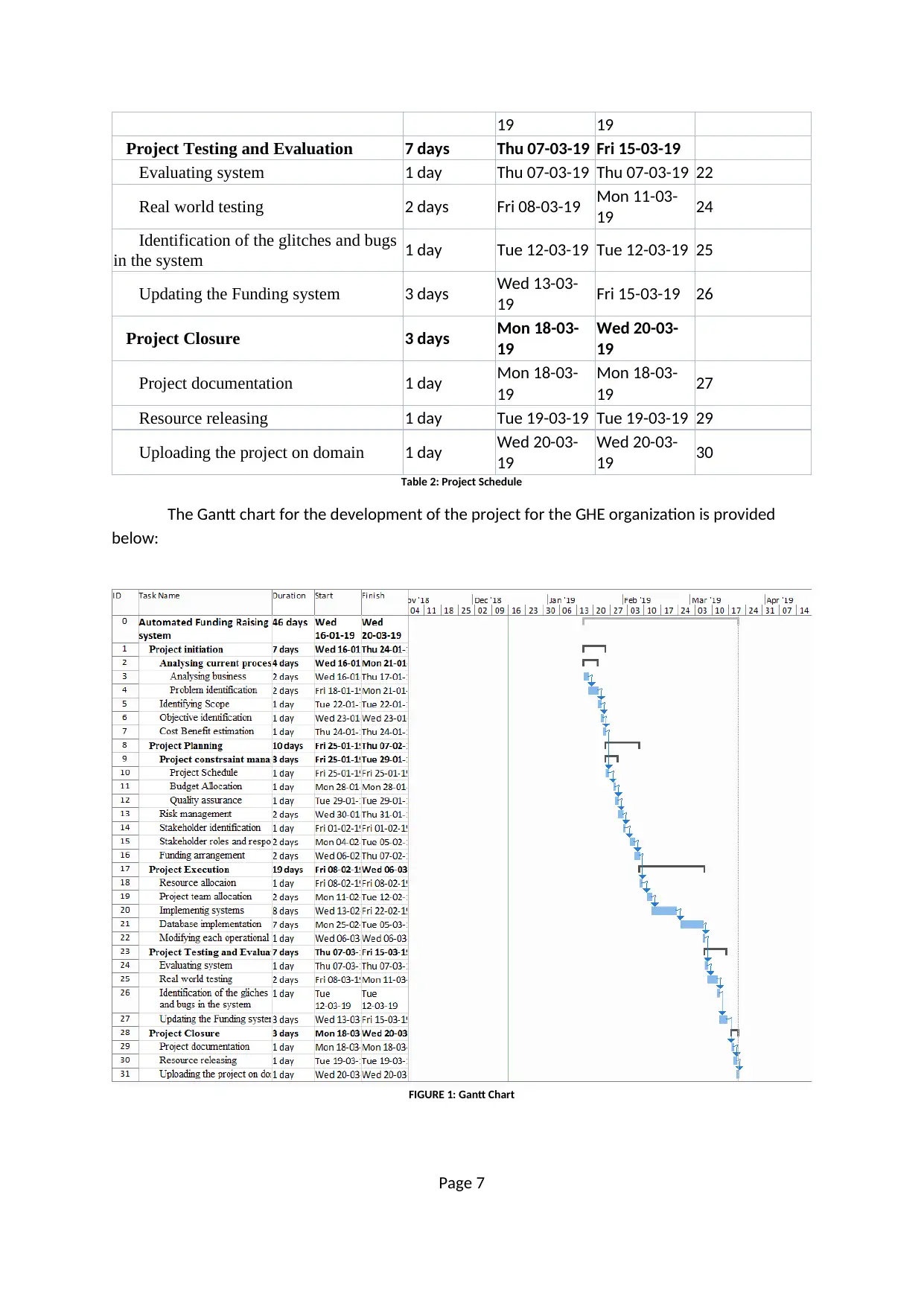
19 19
Project Testing and Evaluation 7 days Thu 07-03-19 Fri 15-03-19
Evaluating system 1 day Thu 07-03-19 Thu 07-03-19 22
Real world testing 2 days Fri 08-03-19 Mon 11-03-
19 24
Identification of the glitches and bugs
in the system 1 day Tue 12-03-19 Tue 12-03-19 25
Updating the Funding system 3 days Wed 13-03-
19 Fri 15-03-19 26
Project Closure 3 days Mon 18-03-
19
Wed 20-03-
19
Project documentation 1 day Mon 18-03-
19
Mon 18-03-
19 27
Resource releasing 1 day Tue 19-03-19 Tue 19-03-19 29
Uploading the project on domain 1 day Wed 20-03-
19
Wed 20-03-
19 30
Table 2: Project Schedule
The Gantt chart for the development of the project for the GHE organization is provided
below:
FIGURE 1: Gantt Chart
Page 7
Project Testing and Evaluation 7 days Thu 07-03-19 Fri 15-03-19
Evaluating system 1 day Thu 07-03-19 Thu 07-03-19 22
Real world testing 2 days Fri 08-03-19 Mon 11-03-
19 24
Identification of the glitches and bugs
in the system 1 day Tue 12-03-19 Tue 12-03-19 25
Updating the Funding system 3 days Wed 13-03-
19 Fri 15-03-19 26
Project Closure 3 days Mon 18-03-
19
Wed 20-03-
19
Project documentation 1 day Mon 18-03-
19
Mon 18-03-
19 27
Resource releasing 1 day Tue 19-03-19 Tue 19-03-19 29
Uploading the project on domain 1 day Wed 20-03-
19
Wed 20-03-
19 30
Table 2: Project Schedule
The Gantt chart for the development of the project for the GHE organization is provided
below:
FIGURE 1: Gantt Chart
Page 7
⊘ This is a preview!⊘
Do you want full access?
Subscribe today to unlock all pages.

Trusted by 1+ million students worldwide
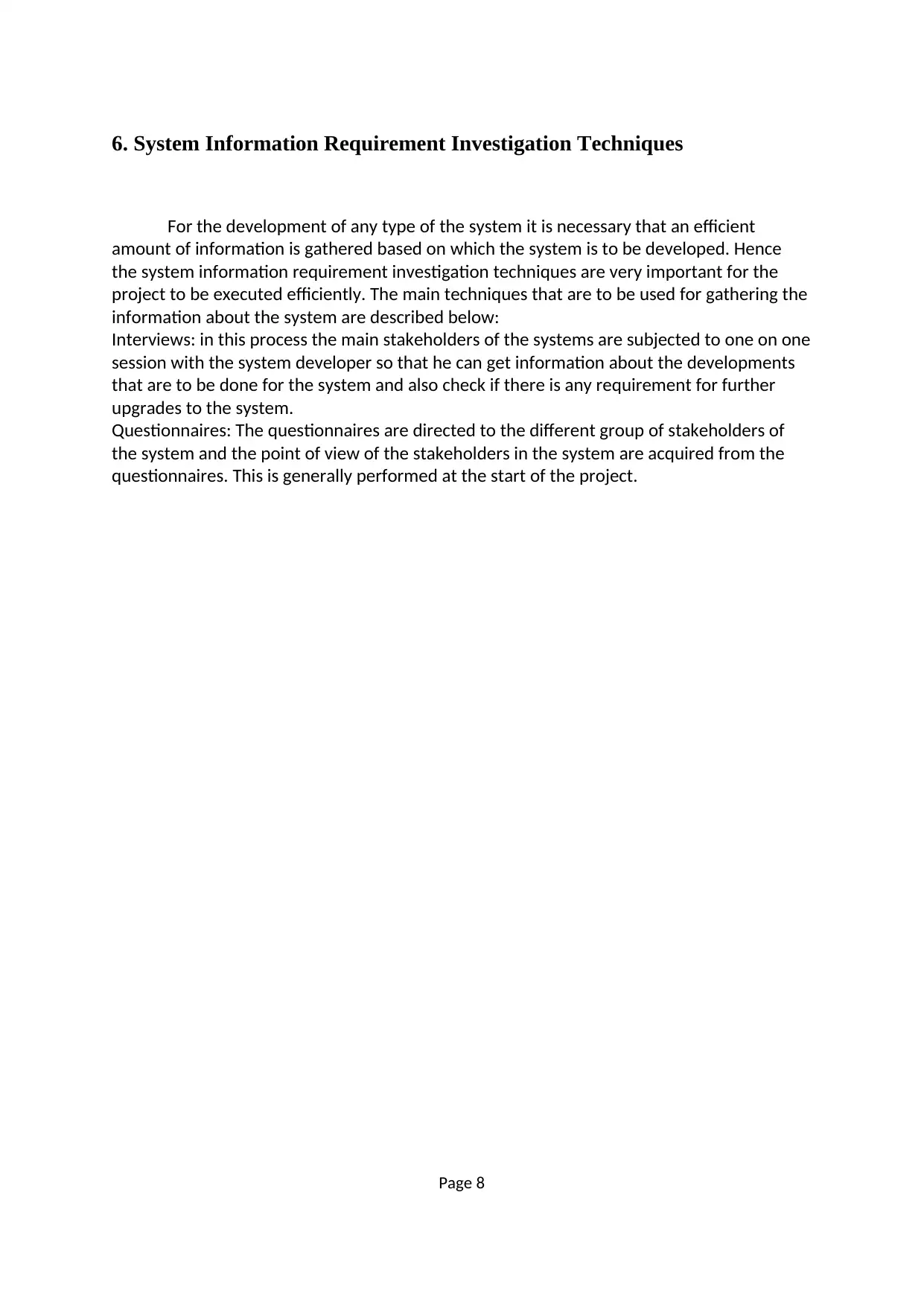
6. System Information Requirement Investigation Techniques
For the development of any type of the system it is necessary that an efficient
amount of information is gathered based on which the system is to be developed. Hence
the system information requirement investigation techniques are very important for the
project to be executed efficiently. The main techniques that are to be used for gathering the
information about the system are described below:
Interviews: in this process the main stakeholders of the systems are subjected to one on one
session with the system developer so that he can get information about the developments
that are to be done for the system and also check if there is any requirement for further
upgrades to the system.
Questionnaires: The questionnaires are directed to the different group of stakeholders of
the system and the point of view of the stakeholders in the system are acquired from the
questionnaires. This is generally performed at the start of the project.
Page 8
For the development of any type of the system it is necessary that an efficient
amount of information is gathered based on which the system is to be developed. Hence
the system information requirement investigation techniques are very important for the
project to be executed efficiently. The main techniques that are to be used for gathering the
information about the system are described below:
Interviews: in this process the main stakeholders of the systems are subjected to one on one
session with the system developer so that he can get information about the developments
that are to be done for the system and also check if there is any requirement for further
upgrades to the system.
Questionnaires: The questionnaires are directed to the different group of stakeholders of
the system and the point of view of the stakeholders in the system are acquired from the
questionnaires. This is generally performed at the start of the project.
Page 8
Paraphrase This Document
Need a fresh take? Get an instant paraphrase of this document with our AI Paraphraser
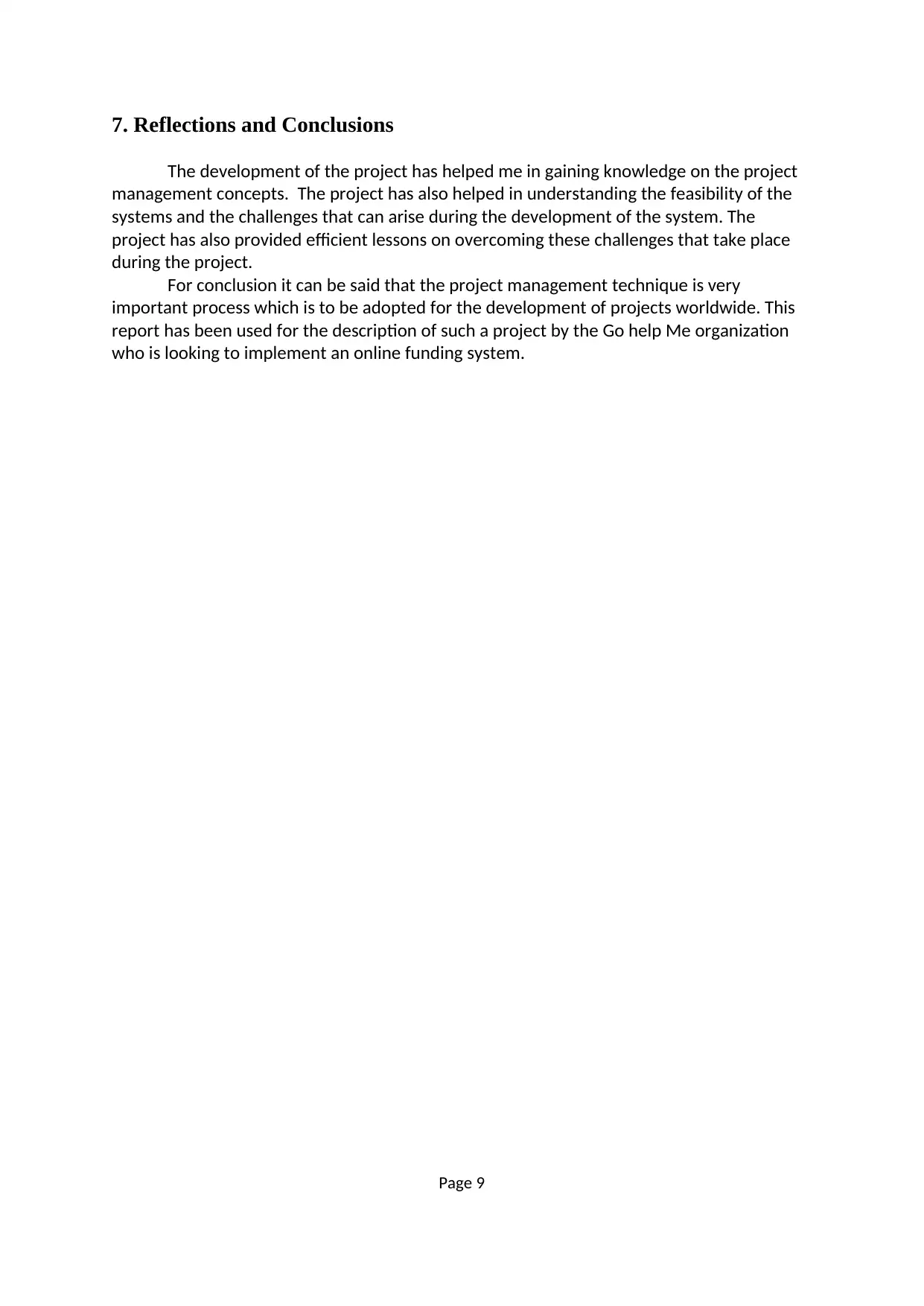
7. Reflections and Conclusions
The development of the project has helped me in gaining knowledge on the project
management concepts. The project has also helped in understanding the feasibility of the
systems and the challenges that can arise during the development of the system. The
project has also provided efficient lessons on overcoming these challenges that take place
during the project.
For conclusion it can be said that the project management technique is very
important process which is to be adopted for the development of projects worldwide. This
report has been used for the description of such a project by the Go help Me organization
who is looking to implement an online funding system.
Page 9
The development of the project has helped me in gaining knowledge on the project
management concepts. The project has also helped in understanding the feasibility of the
systems and the challenges that can arise during the development of the system. The
project has also provided efficient lessons on overcoming these challenges that take place
during the project.
For conclusion it can be said that the project management technique is very
important process which is to be adopted for the development of projects worldwide. This
report has been used for the description of such a project by the Go help Me organization
who is looking to implement an online funding system.
Page 9
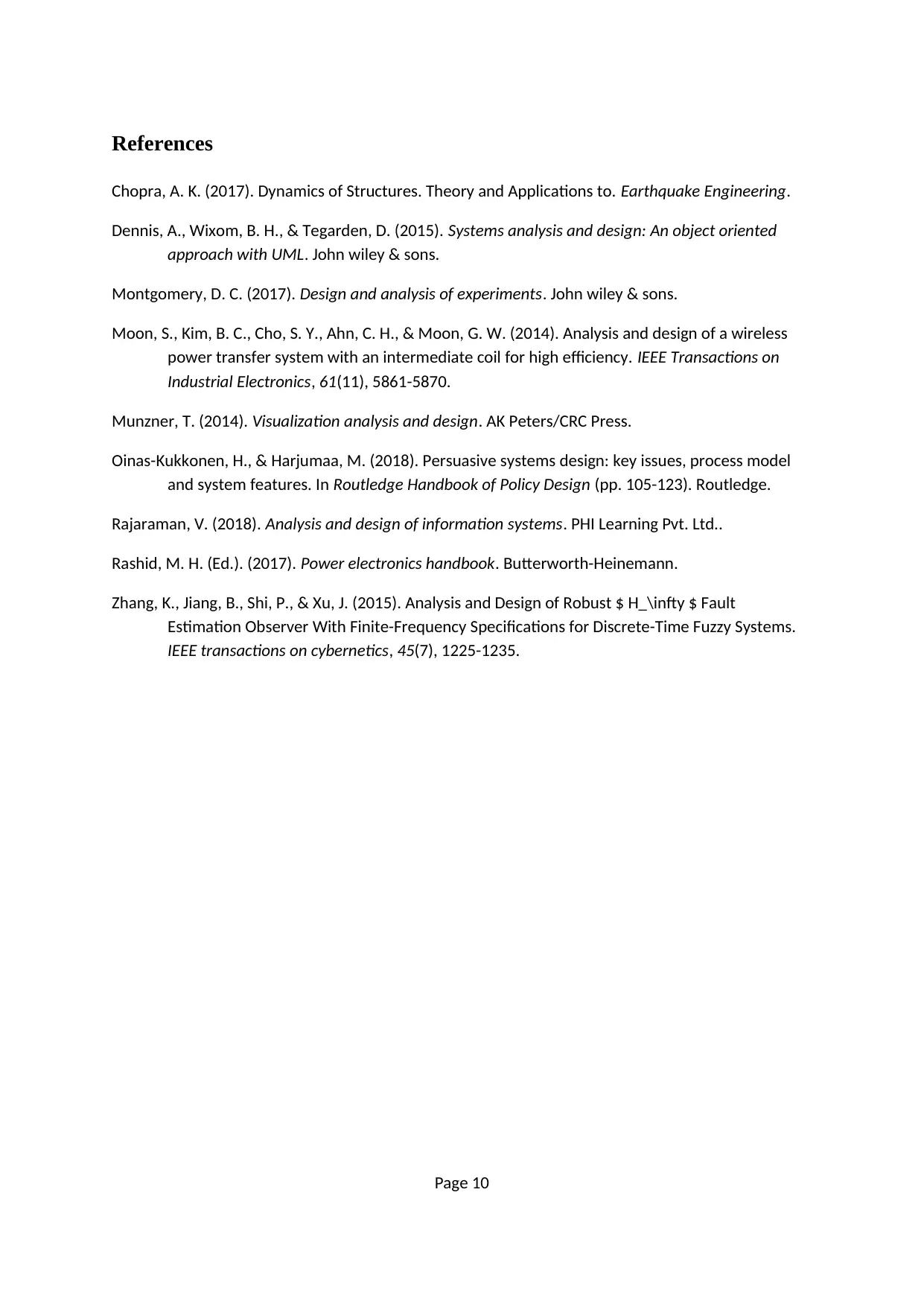
References
Chopra, A. K. (2017). Dynamics of Structures. Theory and Applications to. Earthquake Engineering.
Dennis, A., Wixom, B. H., & Tegarden, D. (2015). Systems analysis and design: An object oriented
approach with UML. John wiley & sons.
Montgomery, D. C. (2017). Design and analysis of experiments. John wiley & sons.
Moon, S., Kim, B. C., Cho, S. Y., Ahn, C. H., & Moon, G. W. (2014). Analysis and design of a wireless
power transfer system with an intermediate coil for high efficiency. IEEE Transactions on
Industrial Electronics, 61(11), 5861-5870.
Munzner, T. (2014). Visualization analysis and design. AK Peters/CRC Press.
Oinas-Kukkonen, H., & Harjumaa, M. (2018). Persuasive systems design: key issues, process model
and system features. In Routledge Handbook of Policy Design (pp. 105-123). Routledge.
Rajaraman, V. (2018). Analysis and design of information systems. PHI Learning Pvt. Ltd..
Rashid, M. H. (Ed.). (2017). Power electronics handbook. Butterworth-Heinemann.
Zhang, K., Jiang, B., Shi, P., & Xu, J. (2015). Analysis and Design of Robust $ H_\infty $ Fault
Estimation Observer With Finite-Frequency Specifications for Discrete-Time Fuzzy Systems.
IEEE transactions on cybernetics, 45(7), 1225-1235.
Page 10
Chopra, A. K. (2017). Dynamics of Structures. Theory and Applications to. Earthquake Engineering.
Dennis, A., Wixom, B. H., & Tegarden, D. (2015). Systems analysis and design: An object oriented
approach with UML. John wiley & sons.
Montgomery, D. C. (2017). Design and analysis of experiments. John wiley & sons.
Moon, S., Kim, B. C., Cho, S. Y., Ahn, C. H., & Moon, G. W. (2014). Analysis and design of a wireless
power transfer system with an intermediate coil for high efficiency. IEEE Transactions on
Industrial Electronics, 61(11), 5861-5870.
Munzner, T. (2014). Visualization analysis and design. AK Peters/CRC Press.
Oinas-Kukkonen, H., & Harjumaa, M. (2018). Persuasive systems design: key issues, process model
and system features. In Routledge Handbook of Policy Design (pp. 105-123). Routledge.
Rajaraman, V. (2018). Analysis and design of information systems. PHI Learning Pvt. Ltd..
Rashid, M. H. (Ed.). (2017). Power electronics handbook. Butterworth-Heinemann.
Zhang, K., Jiang, B., Shi, P., & Xu, J. (2015). Analysis and Design of Robust $ H_\infty $ Fault
Estimation Observer With Finite-Frequency Specifications for Discrete-Time Fuzzy Systems.
IEEE transactions on cybernetics, 45(7), 1225-1235.
Page 10
⊘ This is a preview!⊘
Do you want full access?
Subscribe today to unlock all pages.

Trusted by 1+ million students worldwide
1 out of 12
Related Documents
Your All-in-One AI-Powered Toolkit for Academic Success.
+13062052269
info@desklib.com
Available 24*7 on WhatsApp / Email
![[object Object]](/_next/static/media/star-bottom.7253800d.svg)
Unlock your academic potential
Copyright © 2020–2025 A2Z Services. All Rights Reserved. Developed and managed by ZUCOL.





